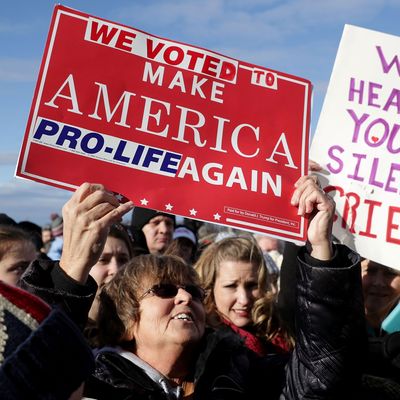
As its legions assemble in Washington for the annual ritual of the March for Life, the movement that has fought for 43 years to recriminalize abortion is feelin’ pretty good. Just a few months ago, it looked like one of America’s most resolute pro-choice pols was about to win the presidency. Before that, it appeared the right-to-life movement’s iron grip on the GOP might slip, as someone who owed it nothing won the Republican presidential nomination.
But now everything’s coming up roses. Donald Trump improbably won in November, after passing all sorts of initiation tests for enrollment in the RTL cause. The GOP controls both houses of Congress, even as pro-choice Republicans are hunted to virtual extinction. After successfully convincing Senate Republicans to break all precedent by sitting on an Obama Supreme Court nomination for nearly a year, RTLers can look forward to a Trump selection for the high court chosen from a list carefully pre-vetted by the Heritage Foundation and the Federalist Society, both places where anyone not sworn to favor the overturning of Roe v. Wade would not make it past the first job interview. Trump has already performed the traditional first-day act of GOP presidential allegiance to the cause by reviving (and actually expanding) the so-called Mexico City Rules banning use of U.S. funds by any international organization thought to promote abortion. And he’s signed off on other RTL priorities, like a permanent version of the Hyde Amendment banning use of federal funds for abortions here at home.
Cheerful as they were as they listened today to a speech from an old friend who is suddenly very powerful, Vice-President Mike Pence, some RTLers may pause to realize they were at this juncture before, 16 years ago. That’s when the only Republican president rivaling Ronald Reagan as a vocal supporter of elevating the rights of the “unborn” over the rights of grown-up women took office, George W. Bush.
Unlike his old man, W. was not a late-life convert to the cause of outlawing abortion. His conservative evangelical reputation gave RTLers a reason to believe his stated convictions. And he more or less delivered. He was the first Republican president since Herbert Hoover who did not appoint a Supreme Court justice complicit in creating or defending the constitutional right to choose. And he extended the anti-abortion fight into new territory with his opposition to federal funding for embryonic stem-cell research.
But it was on another symbolic issue that both Bush and the RTL movement experienced a Waterloo in 2005: the bizarre, unsuccessful effort, which included a special session of Congress, to intervene in a state court’s direction of end-of-life care for a Florida woman named Terri Schiavo. The Schiavo incident was an exercise in egregious hubris that may have set back the cause by many years.
On the all-important legal front, the Bush era witnessed what initially appeared to be a breakthrough that challenged the inviolability of abortion rights: the 2007 Gonzales v. Carhart decision. Carhart not only upheld a federal ban on so-called “partial-birth abortion,” but seemed, through the majority opinion from Justice Anthony Kennedy, to open a whole new line of challenges to Roe v. Wade, by making dubious claims involving the health of the woman seeking an abortion a rationale for letting legislators deny her the procedure.
Republican-controlled state government flooded through this opening (especially after the GOP landslide of 2010) with all sorts of “TRAP” (Targeted Restrictions on Abortion Providers) laws ostensibly regulating conditions in abortion clinics but clearly aimed at shutting them down. And then, in a very good demonstration of how capricious constitutional law can be in this area, the same Justice Kennedy who opened this door helped slam it shut, by concurring with Justice Breyer’s 2016 opinion in Whole Woman’s Health v. Hellerstedt that Texas’s classic TRAP law on clinic requirements constituted an “undue burden” on abortion rights.
Kennedy’s position in this 5–3 decision pretty clearly indicated that after Justice Antonin Scalia’s death there are only three reliable votes on the Court to reverse or seriously restrict Roe.
And so all those Marchers for Life understand that they need at least two SCOTUS appointments from their unlikely champion Donald Trump before they can proclaim victory and turn their attentions to vicious state-by-state trench warfare against legalized abortion.
The wiser among them surely understand that while they avoided disaster last November, triumph could be far away, and will in no small part rely on perhaps the most erratic chief executive since Nixon, the Republican who placed on the Court the justice (Harry Blackmun) who wrote Roe v. Wade.






























